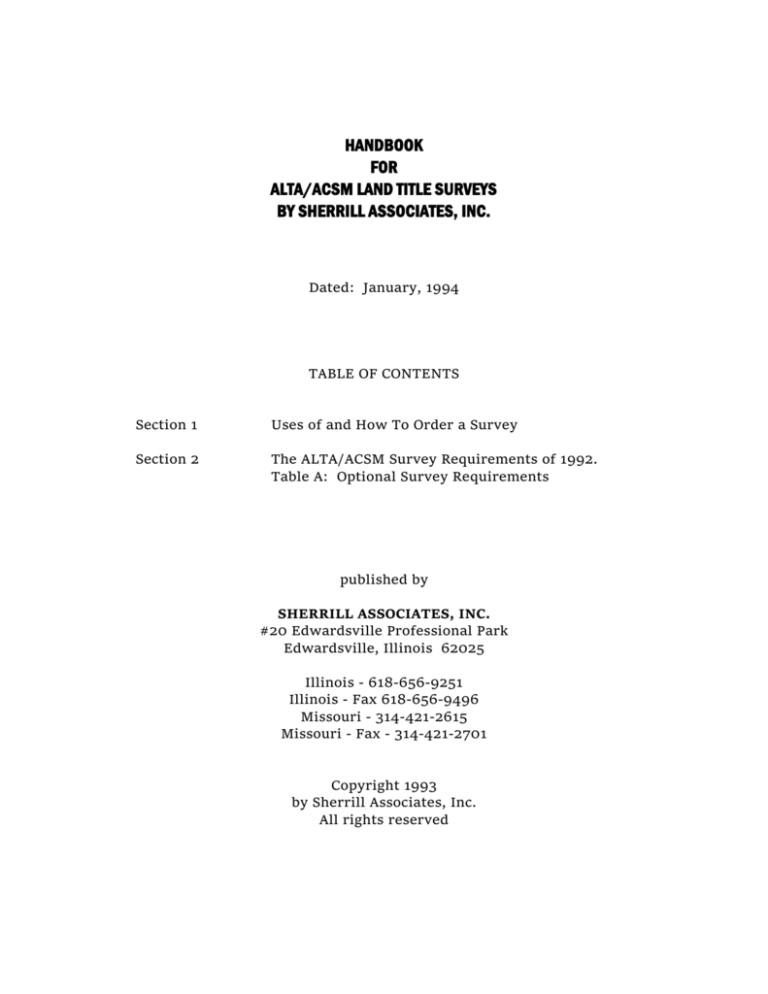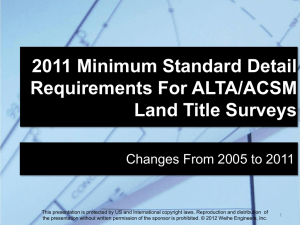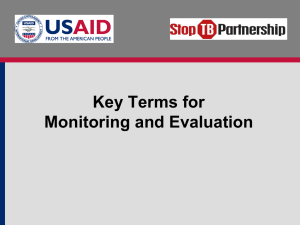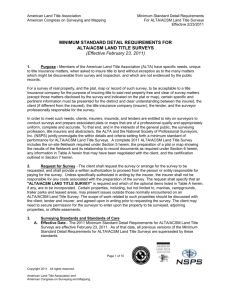
HANDBOOK
FOR
ALTA/ACSM LAND TITLE SURVEYS
BY SHERRILL ASSOCIATES, INC.
Dated: January, 1994
TABLE OF CONTENTS
Section 1
Uses of and How To Order a Survey
Section 2
The ALTA/ACSM Survey Requirements of 1992.
Table A: Optional Survey Requirements
published by
SHERRILL ASSOCIATES, INC.
#20 Edwardsville Professional Park
Edwardsville, Illinois 62025
Illinois - 618-656-9251
Illinois - Fax 618-656-9496
Missouri - 314-421-2615
Missouri - Fax - 314-421-2701
Copyright 1993
by Sherrill Associates, Inc.
All rights reserved
Uses of and How To Order a Survey
For the non-surveyor, this section explains what an ALTA/ACSM Survey is, who
relies upon and benefits from it, and what information is needed by the surveyor to
submit a proposal and then to perform the survey.
The ALTA/ACSM survey is a picture of the property showing (1) the surveyor's
findings about the property boundaries, (2) the easements and exceptions to coverage
cited in the title commitment and (3) the improvements and utilities within the insured
estate. In past years similar surveys were called "as built surveys" or "improvement
surveys." These are no longer the same since the ALTA/ACSM Survey incorporates
many other elements to alleviate the concerns of multiple parties. The ALTA/ACSM
survey is a boundary survey, a title survey, and an improvement location survey
wrapped in one package.
The lender and buyer are concerned about the present and future use of the land
and all restrictions, encumbrances and benefits that come with owning or potentially
owning the property. The ALTA/ACSM Survey provides a picture of all these concerns
so the lender or buyer can evaluate the risks and benefits of owning the property.
The title insurer is asked by the lender and/or buyer to provide insurance
against potential use losses or claims against the land that may arise after the purchase
of the property. Such insurance includes protection for the lender or buyer against (1)
boundary line conflicts with adjoining properties, (2) encroachments onto and from
adjoining properties, (3) rights of third parties onto the property usually in the form of
easements, leases or other encumbrances, (4) the contiguity, or lack thereof, of multiple
parcels that combine to form the property, and (5) access to public highways. The
insurer uses the survey to assess the risks of issuing such insurance and to determine
what exceptions from coverage must be included within their policy. Prior to the
issuance of a Title Insurance Policy, the title company usually provides a Title
Commitment that cites the property interest to be insured and the exceptions to
coverage found in public records and other documents. The exceptions to coverage
usually include matters that would be disclosed on an accurate survey. The ALTA/ACSM
survey is used and relied upon by the insurer to remove or add exceptions to coverage
and thereby issue various types of coverage requested by the lender or buyer. The
surveyor's duty to the title company is to report or graphically show how potential
claims by others may affect the property and result in a loss due to a claim on their
insurance policy.
The seller of a property also uses and relies upon the ALTA/ACSM survey to
protect him against potential claims from the buyer after conveyance. The seller is
frequently asked within a purchase agreement to guarantee all improvements are
located within property boundaries, all improvements comply with current zoning
regulations, others do not have rights on to the property other than those disclosed in
the form of easements, leases or other encumbrances and no boundary line conflicts
exist with adjoining owners.
With all the above users of the ALTA/ACSM survey, the surveyor frequently is
involved in a complex set of responsibilities because of the multiple parties to the
typical real estate transaction. To compound this, the buyer, seller, and lender
frequently engage counsels to represent their interests. Even though the surveyor is
engaged by one client responsible for paying his fees, his obligations usually extend to
the other parties. Such extended obligations can be reduced by initially compiling and
defining the requirements for the survey before the surveyor begins his work.
The ALTA/ACSM survey is based upon a current title commitment. The
commitment states the limits of the property being surveyed and the easements of
record that affect the land. The survey then verifies the legal description is
dimensionally correct with adjoining deeds and that the easements of the commitment
do affect the lands. It also displays uses that cross boundaries, called encroachments.
Thus a current title commitment or report must be provided before an ALTA/ACSM
survey is completed.
If a current title commitment does not exist when a survey is ordered, then the
surveyor must make considerable assumptions. These include the number of easements
to show on the survey and often the limits of the land to include in the survey. If he
assumes to much land or too many easements, then his fee estimate will be high. If he
assumes the opposite, then his fee will be too low.
To request a proposal to perform an ALTA/ACSM Survey, the following
information should be delivered to the surveyor:
Name of the current Owner
Name of Lessor, if a leasehold
Name of the Purchaser, if known or applicable
Name of the Lender, if known
Mailing address of the property
Legal Description
Current or Prior Title Commitment with copies of supportive documents,
available
Survey Requirements: A copy of Table A to the 1992 ALTA/ACSM Land
Survey Requirements with those desired optional items checked, plus any
specific requirements, perhaps by the lender or buyer, not specifically
(See Page 9)
The required Surveyor's Certificate to be placed on the survey.
if
Title
listed.
MINIMUM STANDARD DETAIL REQUIREMENTS FOR
ALTA/ACSM LAND TITLE SURVEYS
as adopted by
American Land Title Association
and American Congress on Surveying & Mapping
in 1992
It is recognized that members of the American Land Title Association (ALTA)
have specific needs, peculiar to title insurance matters, which require particular
information for acceptance by title insurance companies when said companies are asked
to insure title to land without exceptions as to the many matters which might be
discoverable from survey and inspection and not be evidenced by the public records. In
the general interest of the public, the surveying profession, title insurers and
abstracters, ALTA and the American Congress on Surveying and Mapping (ACSM) jointly
promulgate and set forth such details and criteria for standards. It is understood that
local variations may require local situations, and often must be applied. It is
recognized that title insurance companies are entitled to rely on the survey furnished to
them being of the appropriate professional quality, both as to completeness and as to
accuracy. It is equally recognized that for the performance of a survey, the surveyor
will be provided with appropriate data which can be relied upon in the preparation of
the survey.
For a survey of real property and the plat or map of the survey to be acceptable
to a title insurance company for purposes of insuring title to said real property free and
clear of survey matters (except those matters disclosed by the survey and indicated on
the plat or map), certain specific and pertinent information shall be presented for the
distinct and clear understanding between the client (insured), the title insurance
company (insurer), and the surveyor (the person professionally responsible for the
survey). These requirements are:
1.
The client shall request the survey or arrange for the survey to be
requested and shall provide a written authorization to proceed with the survey form the
person responsible for paying for the survey. The request shall specify that an Urban,
Suburban, Rural or Mountain and Marshland "ALTA/ACSM LAND TITLE SURVEY" is
required, meeting the then-current accuracy standards jointly adopted by ALTA and
ACSM. The request shall also designate which of the optional items listed in Table A are
to be incorporated. The request shall set forth the record description of the property.
The record description of the property, any record easements benefiting the property,
the record easements or servitudes and covenants affecting the property ("Record
Document"), the names and deed data of all adjacent owners, as available, and any
other documents containing desired appropriate information affecting the property
being surveyed and to which the survey shall make reference shall be provided to the
surveyor for notation on the plat or map of survey.
2.
The plat or map of such survey shall bear the name, address, telephone
number, and signature of the professional land surveyor who made the survey, his or
her official seal and registration number, the date the survey was completed and the
dates of all revisions, and the caption "ALTA/ACSM Land Title Survey" with the
certification set forth in paragraph 8.
3.
An "ALTA/ACSM LAND TITLE SURVEY" shall be an Urban, Suburban,
Rural or Mountain and Marshland Survey in accordance with the then-current
"Classification and Specifications for Cadastral Surveys" as adopted, from time to time,
by the American Congress on Surveying and Mapping and the American Land Title
Association and incorporated herein by reference.
4.
On the plat or map of an "ALTA/ACSM LAND TITLE SURVEY," the survey
boundary shall be drawn to a convenient scale, with that scale clearly indicated. A
graphic scale, shown in feet or meters or both, shall be included. A North arrow shall
be shown and when practicable, the plat or map of survey shall be oriented so that
North is at the top of the drawing. Symbols or abbreviations used shall be identified on
the face of the plat or map by use of a legend or other means. If necessary for clarity,
supplementary or exaggerated diagrams shall be presented accurately on the plat or
map. The plat or map shall be a minimum size of 8 1/2 by 11 inches.
5.
The survey shall be performed on the ground and the plat or map of an
"ALTA/ACSM LAND TITLE SURVEY" shall contain, in addition to the required items
already specified above, the following applicable information:
(a)
All data necessary to indicate the mathematical dimensions and relationship of
the boundary represented, with angles given directly or by bearings, and with the
length and radius of each curve, together with elements necessary to mathematically
define each curve. The point of beginning of the surveyor's description shall be shown
as well as the remote point of beginning if different. A bearing base shall refer to some
well-fixed bearing line, so that the bearings may be easily re-established. All bearings
around the boundary shall read in a clockwise direction wherever possible. The North
arrow shall be referenced to its bearing base and should that bearing base differ from
record title, that difference shall be noted.
(b)
When record bearings or angles or distance differ from measured bearings,
angles or distances, both the record and measured bearings, angles, and distances shall
be clearly indicated. If the record description fails to form a mathematically closed
figure, the surveyor shall so indicate.
(c)
Measured and record distance from corners of parcels surveyed to the nearest
right-of-way lines of streets in urban or suburban areas, together with recovered lot
corners and evidence of lot corners, shall be noted. The distances to the nearest
intersecting street shall be indicated and verified. Names and widths of streets and
highways abutting the property surveyed and widths of rights of way shall be given.
Any use contrary to the above shall be noted. Observable evidence of access (or lack
thereof) to such abutting streets of highways shall be indicated. Observable evidence of
private roads shall be so indicated. Streets abutting the premises, which have been
described in Record Documents, but not physically opened, shall be shown and so noted.
(d)
The identifying titles of all recorded plats, filed maps, right of way maps, or
similar documents which the survey represents, wholly or in part, shall be shown with
their appropriate recording data, filing dates and map numbers, and the lot, block and
section numbers or letters of the surveyed premises. Names of adjoining owners as
they appear of record and recorded lot or parcel numbers, recording information
identifying the current description of record, and similar information, where
appropriate, shall be shown. The survey shall indicate platted setback or building
restriction lines which have been recorded in subdivision plats or which appear in a
Record Document which has been delivered to the surveyor. Parcel lines shall clearly
indicate contiguity, gores and overlaps. Where only a part of a recorded lot or parcel is
included in the survey, the balance of the lot or parcel shall be indicated.
(e)
All evidence of monuments, shall be shown and noted to indicate which were
found and which were placed. All evidence of monuments found beyond the surveyed
premises on which establishment of the corners of the surveyed premises are
dependent, and their application related to the survey shall be indicated.
(f)
The character of any and all evidence of possession shall be stated and the
location of such evidence carefully given in relation to both the measured boundary
lines and those established by the record. An absence of notation on the survey shall be
presumptive of no observable evidence of possession.
(g)
The location of all buildings upon the plot or parcel shall be shown and their
locations defined by measurements perpendicular to the boundaries. If there are no
buildings erected on the property being surveyed, the plat or map shall bear the
statement, "No buildings." Proper street numbers shall be shown where available.
(h)
All easements evidence by a Record Document which have been delivered to the
surveyor shall be shown, both those burdening and those benefiting the property
surveyed, indicating recording information. If such an easement cannot be located, a
note to this effect shall be included. Observable evidence of easements and/or
servitudes of all kinds, such as those created by roads; rights-of-way; water courses;
drains; telephone, telegraph, or electric lines; water, sewer, oil or gas pipelines on or
across the surveyed property and on adjoining properties if they appear to affect the
surveyed property, shall be located and noted. If the surveyor has knowledge of any
such easements and/or servitudes, not observable at the time the present survey is
made, such lack of observable evidence shall be noted. Surface indications, if any of
underground easements and/or servitudes shall also be shown.
(i)
The character and location of all walls, buildings, fences, and other visible
improvements within five feet of each side of the boundary lines shall be noted.
Physical evidence of all encroaching structural appurtenances and projections, such as
fire escapes, bay windows, windows and doors that open out, flue pipes, stoops, eaves,
cornices, areaways, steps, trim, etc., by or on adjoining property or on abutting streets,
on any easement or over setback lines shall be indicated with the extent of such
encroachment or projection. If the client wishes to have additional information with
regard to appurtenances such as whether or not such appurtenances are independent,
division, or party walls and are plumb the client will assume the responsibility of
obtaining such permissions as are necessary for the surveyor to enter upon the
properties to make such determinations.
(j)
Driveways and alleys on or crossing the property must be shown. Where there is
evidence of use by other than the occupants of the property, the surveyor must so
indicate on the plat or map. Where driveways or alleys on adjoining properties
encroach, in whole or in part, on the property being surveyed, the surveyor must so
indicate on the plat or map with appropriate measurements.
(k)
As accurately as the evidence permits, the location of cemeteries and burial
grounds (i) disclosed in the process of researching title to the premises or (ii) observed
in the process of performing the field work for the survey, shall be shown.
(l)
Ponds, lakes, springs, or rivers bordering on or running through the premises
being surveyed shall be shown.
6.
As a minimum requirement, the surveyor shall furnish two sets of prints
of the plat or map of survey to the title insurance company of the client. If the plat or
map of survey consists of more than one sheet, the sheets shall be numbered, the total
number of sheets indicated and match lines be shown on each sheet. The prints shall be
on durable and dimensionally stable material of quality standard acceptable to the title
insurance company. At least two copies of the boundary description prepared from the
survey shall be similarly furnished by the surveyor and shall be on the face of the plat
or map of survey, if practicable, or otherwise attached to and incorporated in the plat or
map. Reference to date of the "ALTA/ACSM LAND TITLE SURVEY, surveyor's file
number (if any), political subdivision, section, township and range, along with
appropriate aliquot parts thereof, and similar information shown on the plat or map of
survey shall be included with the boundary description.
7.
Water boundaries necessarily are subject to change due to erosion or
accretion by tidal action or the flow of rivers and streams. A realignment of water
bodies may also occur due to many reasons such as deliberate cutting and filling of
bordering lands or by avulsion. Recorded surveys of natural water boundaries are not
relied upon by title insurers for location of title.
When a property to be surveyed for title insurance purposes contains a natural
water boundary, the surveyor shall measure the location of the boundary according to
appropriate surveying methods and note on the plat or map the date of the
measurement and the caveat that the boundary is subject to change due to natural
causes and that it may or may not represent the actual location of the limit of title.
When the surveyor is aware of changes in such boundaries, the extent of those changes
shall be identified.
8.
When the surveyor has met all of the minimum standard detail
requirements for an ALTA/ACSM Land Title Survey, the following certification shall be
made on the plat:
To (name of client), (name of lender, if known), (name of title insurance
company, if known), (name of others as instructed by client):
This is to certify that this map or plat and the survey on which it is based were
made (i) in accordance with "Minimum Standard Detail Requirements for ALTA/ACSM
Land Title Surveys," jointly established and adopted by ALTA and ACSM in 1992,
includes Items
of Table A thereof, and (ii) pursuant to the Accuracy
Standards (as adopted by ALTA and ACSM and in effect on the date of this certification)
of a(n) [insert "Urban," "Suburban," "Rural," or "Mountain/Marshland" here] Survey.
Date:
(signed)
(seal)
Registration No.
Adopted by the Board of Direction, American Congress on Surveying and Mapping on
November 11, 1992. Adopted by the American Land Title Association on October 17,
1992.
TABLE A
NOTE: The items of Table A must be negotiated between the surveyor and client. It
may be necessary for the surveyor to qualify or expand upon the description of these
items, e.g. in reference to Item 6, there may be a need for an interpretation of a
restriction. The surveyor cannot make a certification on the basis of an interpretation.
Common additional requests to the ALTA/ACSM adopted version are shown below with
underling.
If checked, the following optional items are to be included in the ALTA/ACSM LAND
TITLE SURVEY:
1.
Monuments placed (or a reference monument or witness to the corner) at
all major corners of the boundary of the property, unless already marked
or referenced by an existing monument or witness to the corner except in
the states of California, Oregon and Washington wherein the local
government requires a record plat of new monuments set which mandate
a substantially higher fee to cover review costs.
2.
Vicinity map showing the property surveyed in reference to nearby
highway(s) or major street intersection(s).
3.
Flood zone designation (with property annotation based on Federal Flood
Insurance Rate Maps or the state or local equivalent, by scaled map
location and graphic plotting only). If the property resides in two or
more zones then the survey shall clearly display the limits of each zone
by graphically transposing each zone line from the FIRM to the survey.
4.
Land area as specified by the client.
5.
Contours and the datum of the elevations.
6.
Identify, and show if possible, setback, height and bulk restrictions of
record or disclosed by applicable zoning or building codes (in addition to
those recorded in subdivision maps). If none, so state.
7.
(a) Exterior dimensions of all buildings at ground level
(b) Square footage of:
all
(1) exterior footprint of all buildings, or gross floor area of
buildings, at ground level
(2) other areas to be defined by the client.
(c) Height of all buildings above grade at a defined location.
8.
Substantial, visible improvements (in addition to buildings) such as
signs, parking areas or structures, swimming pools, etc.
9.
Parking areas and, if striped, the striping and the type (e.g. handicapped,
motorcycle, regular, etc.) and number of parking spaces. Designate all
"handicap" spaces as such on the survey. Shown all striped parking
spaces within the fee owned or leased land and within the limits of al
REAs with typical sizes. List in a tabular format the number of regular
spaces, handicap spaces both within the limits of the fee owned or leased
land plus within the limits of any and all REAs.
10.
Indication of access to a public way such as curb cuts, driveways marked.
11.
Location of utilities serving or existing on the property as evidence by
on-site observation or as determined by records provided by client,
utility companies and other appropriate sources (with reference as to the
source of information) for example: (a) railroad tracks and sidings; (b)
manholes, catch basins, valve vaults or other surface indications of
subterranean uses; (c) wires and cables (including their function)
crossing the surveyed premises, all poles on or within ten feet of the
surveyed premises, and the dimensions of all crosswires or overhangs
affecting the surveyed premises; and (d) utility company installations on
the surveyed premises.
(A) in addition to the above the surveyor shall report all visible roof
drains and surface drainage lines, including their outfalls. For hidden
underground utilities the surveyor is to show the approximate location of
underground connecting lines as may be discernible from visible
appurtenances. For hidden underground gravity flow utilities, such as
storm and sanitary sewers, the surveyor shall shown the direction of
flow as may be discernible from visible appurtenances.
(B) The surveyor is to contact each local utility; request them to mark
the ground surface with the location of all their underground or
subsurface appurtenances; field locate and report the ground markings
on the survey map and add appropriate notes to his survey stating the
source of all utility locations shown on his survey including those
utilities who did not respond to his ground marking requests and list
those utilities that may not be located on his survey.
12.
client.
Govermental Agency survey-related requirements as specified by the
13.
Significant observations not otherwise disclosed including, but not
limited to, visible evidence of unusual subsurface matters (such as
underground storage tanks as may be apparent by surface
appurtenances) and general knowledge about the neighborhood (such as
condemnation of the area by US EPA or restricted building heights
imposed by the FAA). If the surveyor questions what is to be reported or
encounters a special reporting problem, he is to consult with his Client.
14.
Areas denoted or restricted in Reciprocal Easement Agreements ("REA").
The surveyor shall shown the limits of any offsite appurtenant
easements on his survey but no improvements or utilities within said
easements need to be field measured and reported on the survey.
However, the surveyor shall show the outlines of any and all buildings
within the REA by transposing building location information from
available site plans, aerial photographs, or other plans and stating the
source of such information on his survey. If no other information is
available showing the location of buildings within the REA, then the
surveyor shall advise the client prior to the completion of his survey. If
the client requires additional field work to locate and report the location
of buildings, then this shall constitute an additional work order beyond
the scope of this survey. In the event the property is disproportionately
smaller than the REA or appurtenant easements, then the surveyor shall
provide on his survey a smaller (larger scale) drawing to depict the area
affected in relationship to the fee or leased land.
15.
Add the limits of any REAs or offsite appurtenant and beneficial
easements to the land subject to your survey and report the location of
all buildings, parking spaces and other improvements on those lands.
16.
The Zoning Classification is needed on each survey. Please report on the
survey (a) the Zoning Classification and the name of that district, if any;
(b) the permitted uses within the Classification; (c) if the existing use
is a non-conforming but permitted use, then any statements you can
make to assure the lenders that the current use is "grandfathered" or
permitted by any special approval, the date of that approval and by
whom; and (d) the source of your information, that is, to whom you
talked with at the zoning authority and their title.
17.
Add a note after your legal description stating it described the same
property as insured in the title commitment. If there are exceptions to
this statement, then qualify such within the note.
18.
Photographs: The surveyor will provide one set of eight to ten 35mm
photographs taken at the time of his survey. The surveyor will also
provide the negatives to the client. One photograph will be a view of the
front of the property taken at the street to shown the general layout or
the improvements. All other photographs will be taken at property
corners looking along property lines. The prints shall be either 3 inches
by 5 inches or 4 inches by 6 inches in size. The back of each print will be
labeled with the date of photo, the number of photo, the position of the
camera (NW corner, NE corner, etc.) and the direction (looking East,
looking West, etc.).
19.
20.
21.
22.
23.
[NOTE: This reprint was based upon copy provided by ACSM on January 6, 1993 and
even though the text is believed to be substantially complete, minor revisions were
expected prior to the official printing by ACSM.]
PLEASE RETURN THIS SHEET IF FURTHER REVISIONS ARE REQUIRED.
TWW February 21, 1994 NEW TYPING
KW 2/22/94 MINOR REVISIONS
C:\GENERAL\STANDARD\SAHANDBK.WPF







